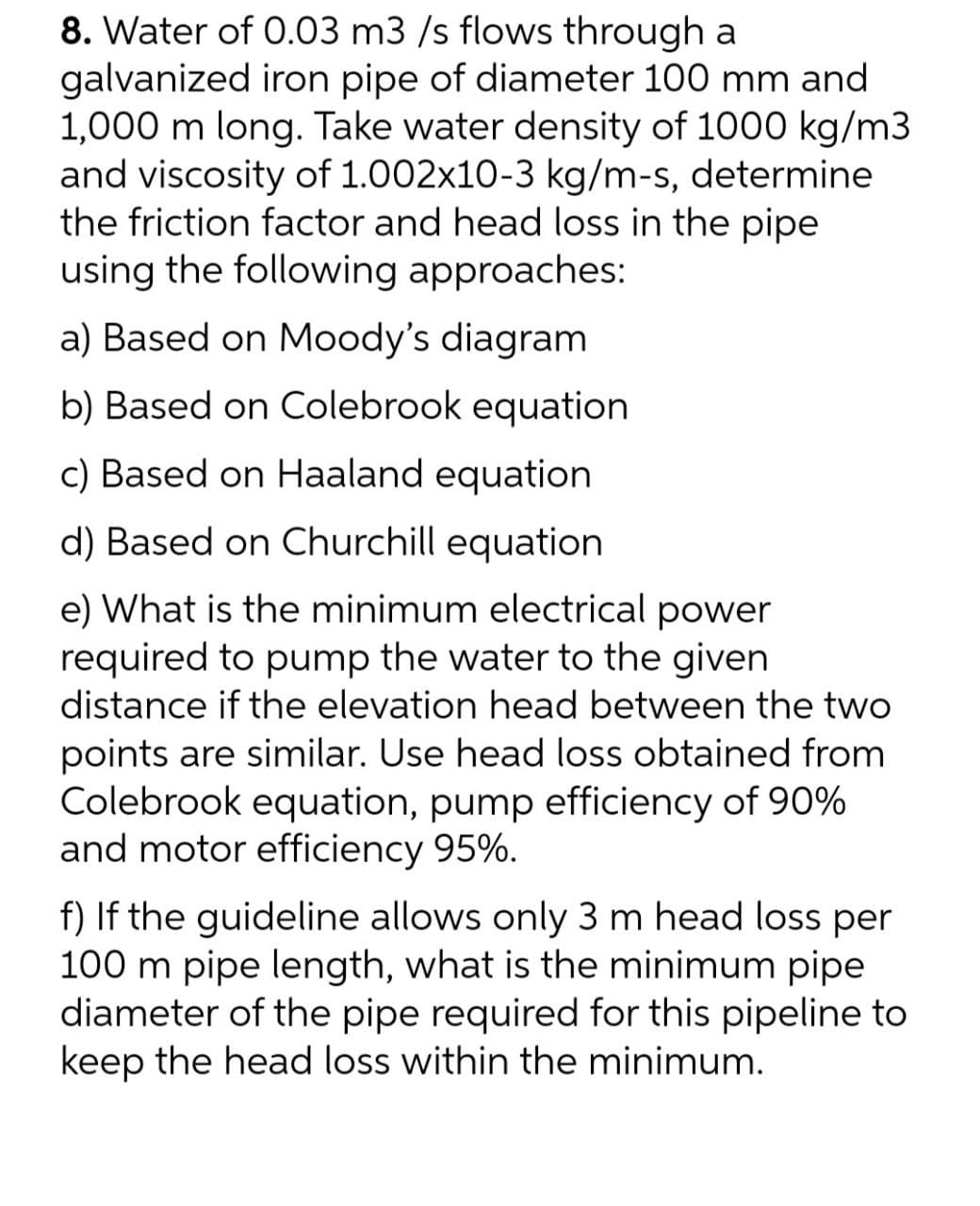8. Water of 0.03 m3 /s flows through a galvanized iron pipe of diameter 100 mm and 1,000 m long. Take water density of 1000 kg/m3 and viscosity of 1.002x10-3 kg/m-s, determine the friction factor and head loss in the pipe using the following approaches: a) Based on Moody's diagram b) Based on Colebrook equation c) Based on Haaland equation d) Based on Churchill equation e) What is the minimum electrical power required to pump the water to the given distance if the elevation head between the two points are similar. Use head loss obtained from Colebrook equation, pump efficiency of 90% and motor efficiency 95%. f) If the guideline allows only 3 m head loss per 100 m pipe length, what is the minimum pipe diameter of the pipe required for this pipeline to keep the head loss within the minimum.
8. Water of 0.03 m3 /s flows through a galvanized iron pipe of diameter 100 mm and 1,000 m long. Take water density of 1000 kg/m3 and viscosity of 1.002x10-3 kg/m-s, determine the friction factor and head loss in the pipe using the following approaches: a) Based on Moody's diagram b) Based on Colebrook equation c) Based on Haaland equation d) Based on Churchill equation e) What is the minimum electrical power required to pump the water to the given distance if the elevation head between the two points are similar. Use head loss obtained from Colebrook equation, pump efficiency of 90% and motor efficiency 95%. f) If the guideline allows only 3 m head loss per 100 m pipe length, what is the minimum pipe diameter of the pipe required for this pipeline to keep the head loss within the minimum.
Chapter2: Loads On Structures
Section: Chapter Questions
Problem 1P
Related questions
Concept explainers
Question

Transcribed Image Text:8. Water of 0.03 m3 /s flows through a
galvanized iron pipe of diameter 100 mm and
1,000 m long. Take water density of 1000 kg/m3
and viscosity of 1.002x10-3 kg/m-s, determine
the friction factor and head loss in the pipe
using the following approaches:
a) Based on Moody's diagram
b) Based on Colebrook equation
c) Based on Haaland equation
d) Based on Churchill equation
e) What is the minimum electrical power
required to pump the water to the given
distance if the elevation head between the two
points are similar. Use head loss obtained from
Colebrook equation, pump efficiency of 90%
and motor efficiency 95%.
f) If the guideline allows only 3 m head loss per
100 m pipe length, what is the minimum pipe
diameter of the pipe required for this pipeline to
keep the head loss within the minimum.
Expert Solution
This question has been solved!
Explore an expertly crafted, step-by-step solution for a thorough understanding of key concepts.
This is a popular solution!
Trending now
This is a popular solution!
Step by step
Solved in 5 steps

Knowledge Booster
Learn more about
Need a deep-dive on the concept behind this application? Look no further. Learn more about this topic, civil-engineering and related others by exploring similar questions and additional content below.Recommended textbooks for you


Structural Analysis (10th Edition)
Civil Engineering
ISBN:
9780134610672
Author:
Russell C. Hibbeler
Publisher:
PEARSON

Principles of Foundation Engineering (MindTap Cou…
Civil Engineering
ISBN:
9781337705028
Author:
Braja M. Das, Nagaratnam Sivakugan
Publisher:
Cengage Learning


Structural Analysis (10th Edition)
Civil Engineering
ISBN:
9780134610672
Author:
Russell C. Hibbeler
Publisher:
PEARSON

Principles of Foundation Engineering (MindTap Cou…
Civil Engineering
ISBN:
9781337705028
Author:
Braja M. Das, Nagaratnam Sivakugan
Publisher:
Cengage Learning

Fundamentals of Structural Analysis
Civil Engineering
ISBN:
9780073398006
Author:
Kenneth M. Leet Emeritus, Chia-Ming Uang, Joel Lanning
Publisher:
McGraw-Hill Education


Traffic and Highway Engineering
Civil Engineering
ISBN:
9781305156241
Author:
Garber, Nicholas J.
Publisher:
Cengage Learning